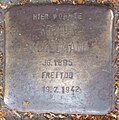Ferdinand Kugelmann
Ferdinand Kugelmann (born May 23, 1840 in Fritzlar ; † July 25, 1915 in Hamburg ) was a German businessman and Hamburg patron .
Life

Kugelmann founded an import and export company in 1871, which made him wealthy. (In 1912 he was ranked 268 millionaires in the three Hanseatic cities.) He imported ivory, pearls, coffee and hemp, among other things. It was exported to Africa, Australia, India and especially to Latin America. a. Building materials, glassware, food and machinery.
From 1881 to 1885 Kugelmann was consul of Argentina in Hamburg, from 1902 until his death, of Guatemala . In 1900 he was one of the founders of the Hamburg riding club. In 1907 he was a co-founder of the Hamburg Scientific Foundation for the establishment of a university in Hamburg . Kugelmann gave rich presents to the Hanseatic city of Hamburg during his lifetime , but was later forgotten. Some of the panels in the main building of the University of Hamburg , which are also supposed to remind of Kugelmann, are old and dull. Kugelmann was a Jew, but left the Jewish community and did not want to convert to Christianity.
Family and their fate
In 1881 he married Elena Hercilia Hahn de Echenagucia († 1940) in Paris. He lived with his family in a large villa on Harvestehuder Weg , what was then known as the “street of millionaires”. The marriage had six children born between 1883 and 1895 and baptized Protestants. One son died in 1907, the sons Ferdinand and Erwin died in 1939. Erwin Kugelmann (* 1885) had his homosexual disposition to fate. Between 1936 and 1938 he was imprisoned three times for short periods in the Fuhlsbüttel concentration camp . He died in June 1939, two days after his release from Holstenwall remand prison. "Bronchial cancer" was given as the cause of death.
In April 1938 the Kugelmanns, like all Jews, had to register their assets. The assets managed by the widow Elena Kugelmann were confiscated. She died in 1940 after falling down a staircase during the war blackout . The daughter Bella (* 1886) emigrated to Venezuela in October 1941 . Her twin sister Maria, who decided to stay with her brother and sister-in-law in Hamburg, was deported to Minsk on November 18, 1941 . On this day their trail is lost. The youngest son Robert (* 1895) married Anna Marie Wolff (* 1905) on June 10, 1942. As a veteran of the First World War, he probably still had hope of survival; on July 3, 1942, he agreed to vacate the villa and move into a so-called “ Jewish house ” on Grindelallee. It never came to that. Robert and Anna Marie Kugelmann committed suicide on July 19, 1942, after they had been ordered to be deported. Only the daughter, who emigrated to Venezuela in 1941, survived the Holocaust . That is why his monumental family grave in the Ohlsdorf cemetery was not tended for years. The broad grave wall with a raised, block-like middle section and a pointed arched portal in the neo-Gothic style is easy to find in the immediate vicinity of the water tower there.
Villa Harvestehuder Weg 55
The once magnificent villa with a floor area of 270 square meters on the corner of Alsterkamp and Harvestehuder Weg, then surrounded by a park-like garden, no longer exists. Due to the ruthless use by the National Socialists, later by the British military authorities, the building was so run down that it was demolished. In its place is a new building from 1972/1974 .
Web links
- Hamburg personalities: Ferdinand Kugelmann
- Renate Hauschildt-Thiessen: Ferdinand Kugelmann (1840–1915) (PDF; 927 kB). In: Johannes Gerhardt: The founders of the Hamburg Scientific Foundation , p. 47
- Matthias Schmoock: The downfall of the patron family Kugelmann . In: Hamburger Abendblatt of December 27, 2002
- Helmut Schoenfeld: The patron Ferdinand Kugelmann . In: OHLSDORF - magazine for mourning culture on .fof-ohlsdorf.de
Individual evidence
- ↑ Hamburg Scientific Foundation : Ferdinand Kugelmann (1840–1915)
- ↑ Matthias Schmoock in the Hamburger Abendblatt 2003
- ↑ Matthias Schmoock: "Ferdinand Kugelmann, born in 1840, is now forgotten in the city that he once gave rich gifts"
- ↑ Helmut Schoenfeld: The patron Ferdinand Kugelmann : “The grave complex is neglected and makes the same impression as the panels in the main building of the university, which u. a. should also remember Kugelmann. ", February 2003
- ↑ Stolpersteine Hamburg
| personal data | |
|---|---|
| SURNAME | Kugelmann, Ferdinand |
| BRIEF DESCRIPTION | German merchant and Hamburg patron |
| DATE OF BIRTH | May 23, 1840 |
| PLACE OF BIRTH | Fritzlar |
| DATE OF DEATH | July 25, 1915 |
| Place of death | Hamburg |




